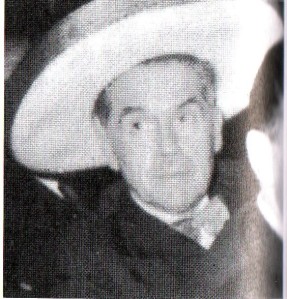It’s been a while since I did a family history post so I thought it was about time I did one, so here you are.
Back in the 1980s a company called Halberts started up a business to exploit the then newly growing hobby of genealogy. They purported to be able to supply customers with accurate information about their family tree and to provide them with a coat of arms. In fact what they actually did was to supply customers with a book entitled the Book of XXX which was essentially a list of names and addresses of XXX culled from telephone directories around the world with a frontispiece claiming to give the history and origins of the name in question, together with a coat of arms. More often than not, these were incorrect. Their claim to respectability was that they had bought the right to use the name of Burke’s Peerage. What they actually did was cause a lot of confusion to fledgling family historians and to make it difficult for genuine family historians, in particular One-Name Studies to gain the trust of those who had fallen victim to the Halbert’s scam. Several articles have been written over the years about this scam and the company has been shut down several times but apparently has miraculous powers of regeneration and continues to pop back into existence. For an interesting read about this duplicitous company see for example: http://blog.eogn.com/eastmans_online_genealogy/2004/08/my_least_favori.html
Scams aside, our surname Leather, appears to cause the editors of surname dictionaries particular difficulties. For example, in the several dictionaries of English or British Surnames, the name is usually described as being derived from workers or sellers of leather such as this shown below from The Internet Surname Index http://www.surnamedb.com/Surname/Leather#ixzz2gSAekBD2
This is an English surname. Recorded as Leather, Lether, Leither, and probably other others, it has two distinct origins. Firstly it may derive from the pre 7th Century male given name “hleothar”, meaning a sound or melody. Though not recorded independently, this personal name forms the first element in such placenames as Leatherhead in Surrey; Letheringham in Suffolk and Letheringsett, Norfolk. These are recorded respectively as Leodridan in the Saxon Chartulary, dated 880, as Letheringaham in the Domesday Book of 1086, and as Letheringsete in the Pipe Rolls of Norfolkin 1254. In his famous book “Patronymica Britannica”, Lower states that “One Lethar was a bishop in the days of Ethelbert” (860 – 865). The surname may also have originated as a metonymic occupational name for a leatherworker or seller of leather goods, from the Middle English and Olde English “lether”, leather. Although the surname itself does not appear until the early 16th Century (see below), the word was used in such occupational names as “Lether-dyer” in London in 1373, and one John Lethercarver was noted in a descriptive catalogue of Ancient Deeds for Northamptonshire, and dated 1404. The modern surname is now found chiefly in Lancashire and Yorkshire. The first recorded spelling of the family name may be that of Robert Lether. This was dated 1524 in the “Subsidy Tax Rolls of Suffolk”, during the reign of King Henry V111, known as “Bluff King Hal”, 1509 – 1547.
If the writers of articles like this actually did their homework, they would realise that their hypothesis of it being a metonymic occupational name was nonsense. If it was an occupational name it would be spread throughout the country instead of being, as even the authors of the above state, that the name in now “found chiefly in the Lancashire and Yorkshire” regions of England. A quick look at the map below derived from the 1881 census data shows this very clearly.
Leather – 1881 per 100,000 people
A few years ago I decided, given the restricted distribution of our name, evidence seemed to suggest an origin near Winwick a town close to Warrington, that it would be very interesting to start a DNA surname study. Imagine my surprise to find that the name Leather was already registered, but as a derivative of the name Lauder! [due entirely to the misinformation given by Halberts] I was incensed and decided that this needed to be corrected immediately. Using the same sources http://www.surnamedb.com/Surname/Lauder#ixzz2gSATbi7f I was able to easily demonstrate that Lauder is a Scottish name recorded in the spellings of Lauder and Lauderdale, this is a famous Scottish locational surname. As Lauder it originates from the village of Lauder in the county of Berwickshire, and as Lauderdale from a name for the western district of the same county of Berwickshire. The translation of the place name and hence the later surname is believed to be from the French-Breton pre 7th century word “laour”, meaning a trench or ditch. The surname is one of the first recorded in Scotland, and early examples taken from authentic rolls and registers of the medieval period include: William de Lawedre, the sheriff of Perthshire in the reign of King Alexander IIIrd of Scotland (1249 – 1286), Alan de Lawadyr, who witnessed a charter by Stephen Fleming, master of the hospital of Soltre in 1426, and Johannes Lathirdale, a notary public, in the city of Glasgow in 1472. Other recordings include Sir David Luthirdale, archdeacon of Dunkeld in 1477, whilst William Lauder, given as being a literary forger, died in 1771. The first recorded spelling of the family name is shown to be that of Sir Robert de Lauedre. This was dated 1250, in the register of the Abbey of Dryburgh and from the map 1881 census data (see below)
Lauder – 1881 per 100,000 people
it is pretty clear that the surnames Leather and Lauder are distinct and non-overlapping.
This story does have a happy ending. As a result of this analysis I was able to get Leather registered as a separate DNA-surname study, although sad to say the various surname dictionaries have not yet manged to change their entries, but I continue to live in hope 🙂
















